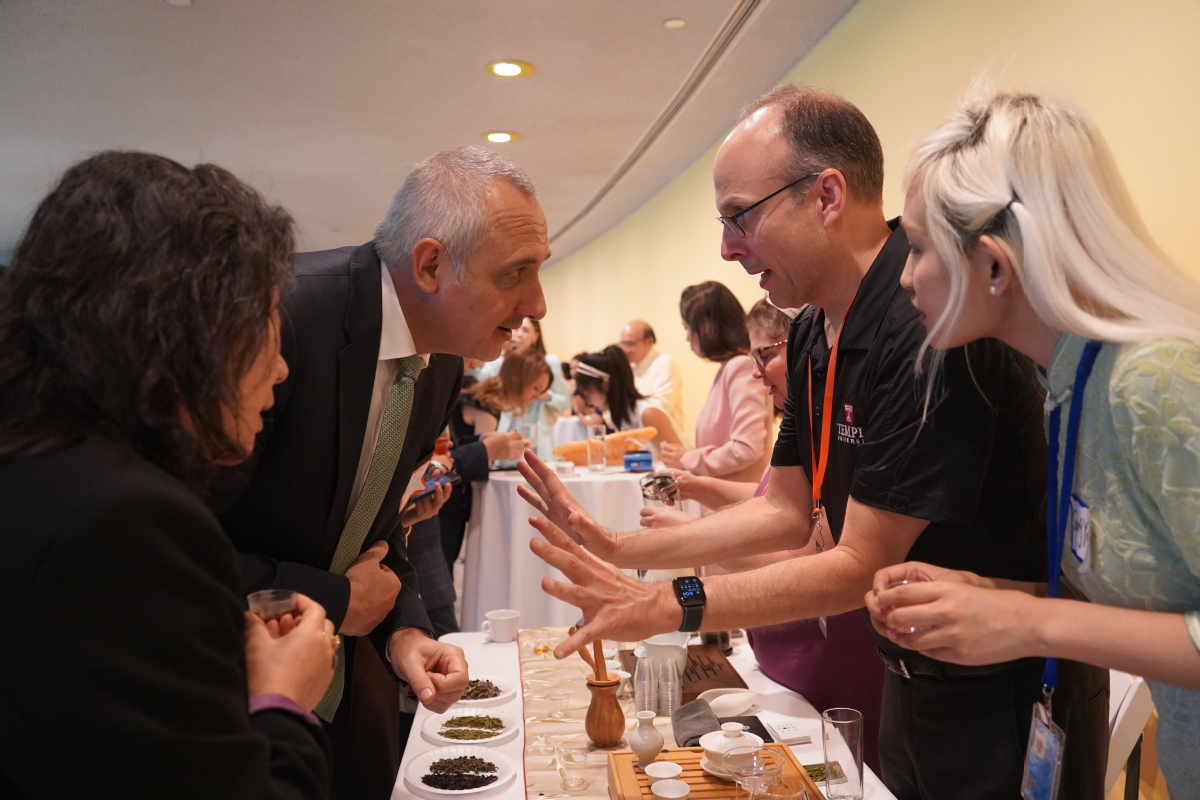UN exhibition showcases cultural fusion
By MINLU ZHANG at the United Nations | chinadaily.com.cn | Updated: 2023-07-01 09:40

The saxophone, cello, and drums were playing jazz music on the one side, while the guqin was playing Chinese tunes on the other side. People were enjoying black tea, white tea, and Pu'er tea on the one side, while others were savoring wine on the opposite side. This was the cultural exhibit that took place at the United Nations Headquarters in New York on Thursday.
"The Chinese civilization is known for its openness, inclusiveness, and dynamics. Through cultural exchanges, the Chinese civilization is constantly gaining new vitality, and at the same time, contributing to the progress and prosperity of world civilizations," Zhang Jun, China's permanent representative to the UN, said at the exhibition.
"Diversity of civilizations is the source of exchanges and mutual learning, which then lead to common development for all," he added.
"Diversity is a richness, not a threat," said Zhang, quoting UN Secretary-General António Guterres. "Both China and the UN have always been champions of the diversity of civilizations. By holding this exhibition at the UN, we are showing our strong support for such diversity and the UN’s work in relevant fields."

Titled "Journey through civilizations – The intangible culture heritage of the world and China", the exhibition was organized by CCTV, the Permanent Mission of China to the UN, the Sino-American Friendship Association, and the UN Staff Recreation Council Chinese Book Club. "It highlights cultural exchanges between China and the rest of the world," Zhang said.
Zhang's speech was echoed by a law professor at Temple University, who was brewing tea for guests at the exhibition.
"In the West, people like to add milk, lemon, and sugar to their tea, while in China, people prefer to drink tea without any additions. This reflects the difference between Chinese and Western tea culture. In India, they have masala tea, which is spiced with ingredients like cardamom," said John Smagula, assistant dean of Beasley School of Law at Temple University.
"This shows that even though tea originated in China, it has integrated into different countries and cultures around the world. Tea is a symbol of unity and relaxation, transcending cultural boundaries," Smagula told China Daily.
Smagula has been learning Chinese for more than 30 years. When he first arrived in China, he used to drink coffee. However, as time went on, Smagula gradually embraced the tea culture.
"I had the opportunity to meet tea enthusiasts, join a tea training class, and immerse myself in the study of tea culture for four years, eventually obtaining a qualification certificate. Through this journey, I discovered that tea culture is incredibly vast and profound," Smagula said, who later created a tea club at the Temple University
"Tea possesses a distinct essence. The way it is brewed and the mindset with which it is prepared significantly influence the ultimate flavor of the tea. Moreover, tea holds the value of traditional Chinese medicine. It truly possesses a captivating charm," he added.
Miguel Moratinos, the high representative for the UN Alliance of Civilizations, and Lily Grey, the liaison officer at UNESCO New York Office, also attended Thursday's exhibition and delivered speeches.
The Chinese term for "civilization" consists of "wen" meaning culture and "ming" meaning enlightenment, which embodies the Chinese people's distinctive understanding of civilization, Moratinos said.
We are currently in a multipolar world where different civilizations should enhance mutual understanding, he said.
Mark Rowswell, better known by his Chinese stage name Dashan, also appeared at Thursday's exhibition.
Accompanied by the jazz music performed by a Canadian band, he recited Li Bai's "The Hard Road to Shu". While Dashan was studying the poem, he said, "Somehow, I could hear the music of John Coltrane, a great jazz saxophone player who used to perform in New York." Inspired by this connection, he decided to recite the poem alongside the jazz music.
At Thursday's exhibition, several ambassadors to the UN and UN officials had the opportunity to experience the printing technology invented by Bi Sheng, the world's first movable type technology.
With the assistance of China’s Ambassador Zhang, ambassadors from various countries printed Du Fu's renowned poem, "Spring Night Rain," on paper. Zhang explained the meaning behind the poem's verses to them.
Under-Secretary-General for General Assembly and Conference Management Movses Abelian, and Under-Secretary-General and Associate Administrator of the UN Development Programme Xu Haoliang, along with representatives and diplomats from various countries, including Pakistan, Russia, Cuba, Burundi, Mozambique, Serbia, Nicaragua, Ethiopia, Belarus, Sri Lanka, Bangladesh, Belgium, Hungary, Greece, Japan, the UK, Thailand, Switzerland, and others, attended the exhibition launching ceremony.
























